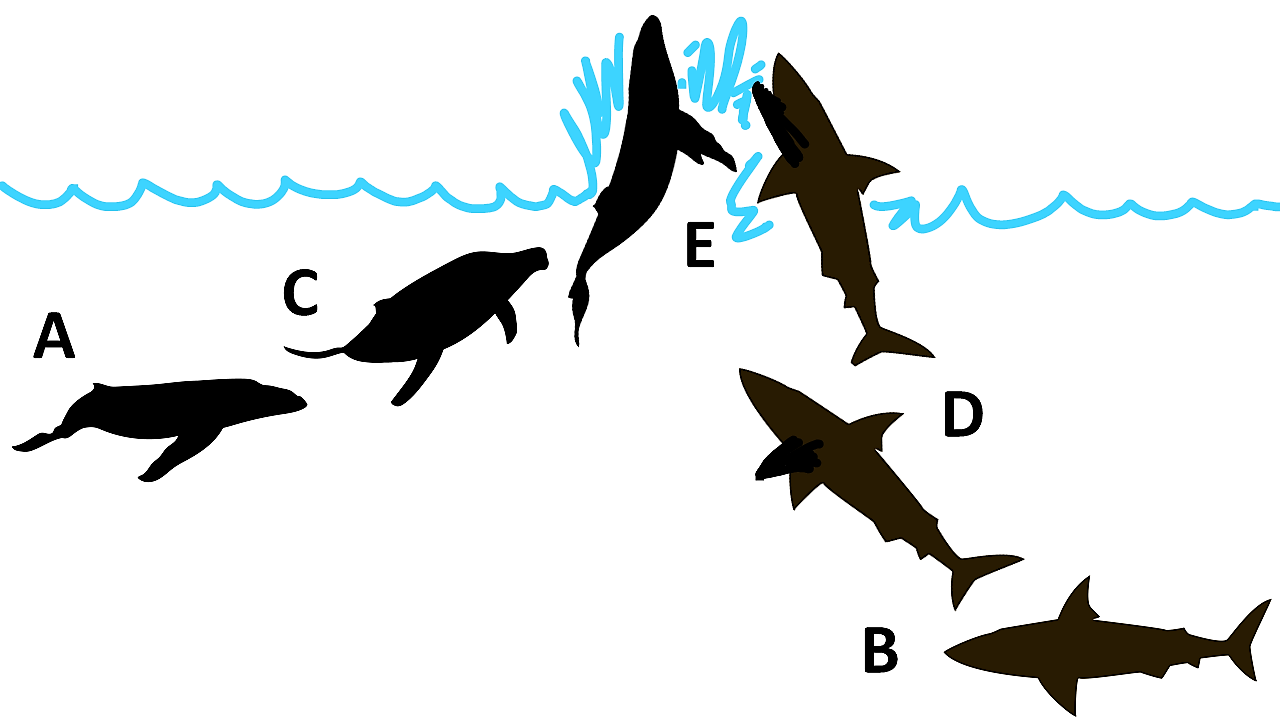WHALE BREACHING – A LEARNED DEFENSIVE BEHAVIOR AGAINST MEGALODON?
One of my personal theories on whale behavior concerns “breaching” – a spectacular display that occurs when a whale rushes skyward at high speed and breaches the surface like a runaway ICBM. This is followed by the leviathan crashing back down with a thunderous splash, spraying water for scores of yards in every direction. It’s a common behavior, with the reason for it being attributed to everything from dislodging skin parasites to plain old youthful exuberance. (Why do whales breach?)
I believe, however, that breaching is a held-over defense mechanism; a learned cetacean response that, over time, became ingrained. We know that cetaceans learn breaching at an early age from other members of the same species. The question is why? I propose that breaching was originally developed as a survival tactic, one used to deflect attacks from one of the whales’ primary predators, the extinct mackerel shark Otodus (Carcharocles) megalodon.

It makes perfect sense. The general presumption is that, when hunting whales, a Megalodon would stalk its prey like a great white does elephant seals; it would creep along the bottom, its dark-colored dorsal blending in with the seafloor. Then, when an unwary cetacean was spotted, it would rush upward at a steep angle, accelerating to its maximum velocity, with the goal of plowing into the whale and disabling it with one monstrous bite.
Of course, whales are far from easy prey. They are intelligent and live in pods and, as can be seen from this pitched battle between a large sperm whale pod and a prowling pack of killer whales, are capable of communicating with others of their kind – including calling for help from long distances – and implementing organized defensive tactics. Pitched battle between Sperm whales and Orcas
In addition, many whales possess echolocation and, due to the advantages of a bony skeleton, at comparable large sizes, were/are more maneuverable than their would-be predator.* Presumably, they would either out-speed the shark or alter course underwater, dodging its “onrushing locomotive” attack. This would be easier than people think. Although a recent special on Megalodon listed the shark as having a maximum speed of only 15 mph (yes, they’ve come around), I think they were being generous. Researchers from Queen’s University in Belfast recently published a study tracking breaches in basking sharks.* They calculated that the planktivorous fish was able to generate as much energy as its cousin, the great white, and travel at a similar speed. A 26.5′ specimen they tagged achieved a maximum speed when breaching of only 11 mph. As I’ve said previously, smaller sharks are faster than larger ones due to the limitations on a skeleton made of cartilage. For example: a similar study on white sharks showed the fastest was a nimble 11.5-foot Carcharodon carcharias cleared the water at a max speed of around 21 mph.** Meanwhile, the giant blue whale has been clocked at 30 mph.***
*https://www.newscientist.com/article/2179238-peaceful-basking-sharks-can-leap-just-as-powerfully-as-great-whites/
**https://www.theatlantic.com/technology/archive/2011/12/the-physics-of-great-white-sharks-leaping-out-of-the-water-to-catch-seals/249799/
***http://www.elasmo-research.org/education/topics/r_haulin%27_bass.htm
If, however, a whale was caught unawares and became cognizant of the Megalodon’s attack at the last moment, dashing away might not have been feasible. its only recourse might have been to breach: to angle its huge body upward in an attempt to offset the shark’s effective angle of attack, and then break for the surface.
As noted on Wikipedia (how whales breach) there are two common types of breaching. The technique utilized primarily by sperm and humpback whales involves making for the surface from deep down and exploding straight upward. The other involves swimming close to the surface and, while at speed, making for the surface to breach with as few as three flaps of the flukes. Either of these – depending on how close the shark was when it started its attack run (and assuming it was detected) – would have allowed the cetacean a chance to, if not avoid an attack altogether, minimize the damage sustained.
If we examine the diagram below we see:
A lone humpback whale (A) detects an approaching Megalodon shark (B).
Sensing the predator’s charge (C) the whale makes for the surface (D)
Breaching the surface at the moment of impact, the whale attempts to reduce the impact of the shark’s charge, spiraling away from its powerful jaws (E).

Although a risky, “Hail Mary” type of play, this type of maneuver is eminently logical. We can safely assume that Megalodons were, like extant great whites, deprived of many of their senses when exposed to air. With their protective sclerotic membrane’s closed, they were extremely limited in terms of vision – practically blind.
Upon breaching the surface, if the initial strike missed or simply grazed the whale, this made any additional attempts on the shark’s part to snap at it fumbling ones at best. (note: in most predator/prey interactions, only one kill in every ten attempts is the norm, and one can assume this was undoubtedly the case here)
In addition, and as exhibited by this video of humpback’s repeatedly breaching, whales tend to torque their bodies while suspended in the air, and continue this maneuver as they come crashing back down.
Most breaches are done this way, (whales breaching) with belly flops being infrequent.*** Combined with reducing the power of the shark’s strike by accelerating away from it (picture two cars grazing one another instead of one t-boning the other at full speed), this body twist would tend to not only allow the whale to spiral away from its attacker, it would also have the potential to dislodge any shark that had clamped down on the whale’s flank, with the subsequent “splash down” finishing the job – an effective way of “rolling with the punch”, so to speak.
Note: in all breaches at least 40% of the cetacean’s body tends to leave the water at an acute angle. For example, sperm whales average thirty degrees to the horizontal.** In addition, the impact of the whale’s 50-ton body may also have had the effect of stunning or even injuring the C. megalodon as the cetacean came slamming back down. It should also be pointed out that blue whales, the largest known living animal, rarely if ever breach, whereas the smaller and agile finback does. With modern great whites using a “size hierarchy” when it comes to others of their kind exceeding them in size, and with their prey generally being limited to marine animals of about their size or smaller (i.e. elephant seals and below), we can safely conclude that the blue whale did not resort to developing breaching behavior because its sheer mass made it all but immune to attacks from C. Megalodon.
Lastly, there are numerous extant precedents for my theory. Seals regularly initiate dodging defenses against white sharks, even at point blank range, and dolphins often engage in mass porpoising at the surface, when hunted by Killer whales. Their bodies leaping clear of the water in unison not only confuses the predator, making it harder to target a lone individual, their airborne maneuvers make it likely that, when initiating a strike, the Orca will miss or only graze its would-be victim. Scaled up, one can easily see how a whale might have used a leap into the air to avoid being crippled or killed by a hungry Megalodon. (see videos below)
So keep this in mind the next time you see a video of a whale breaching the surface, or in person, if you’re so fortunate. Picture a fifty-foot shark erupting from below along with it (or an even larger Livyatan if you prefer), its jaws snapping shut as it attempts to sink its teeth into its unwilling victim.
It makes the splash-down in your mind a thousand times more exciting, don’t you think?
-Max Hawthorne
*At smaller sizes (approx. 30 feet or less) C. megalodon would have been as maneuverable and fleet of foot (flipper) as the cetaceans it stalked – a lethal hunter. At larger, adult sizes, however, its own mass and cartilaginous skeleton would have most likely forced it to subsist mainly on a diet of slow-moving/injured prey items or carcasses. Megalodon: hunter or scavenger?
**Hal Whitehead (2003), Sperm whales: social evolution in the ocean, University of Chicago Press, p. 179, ISBN 0-226-89517-3
***https://en.wikipedia.org/wiki/Cetacean_surfacing_behaviour#cite_note-8


